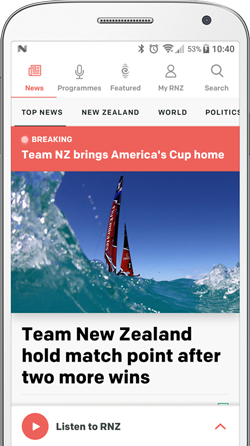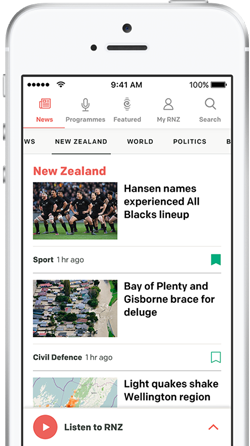
No upgrades have begun on Greenlane Clinical Centre's water system, which was rated very poor in 2020. Photo: RNZ/Maia Ingoe
Five years after the first stocktake of shonky hospital water pipes and power cables, over 40 percent of the worst cases have no work being done on them.
Thirty five out of 82 'very high priority risks' were waiting for work to start, according to Health New Zealand (HNZ)'s most up to date information.
Just 15 out of 82 were recorded as fully fixed - but one of those was Auckland Hospital's water system, that broke down in January, forcing a cancer patient to boil a jug to get hot water.
At nearby Greenlane Clinical Centre, where the water system was rated very poor in 2020, a leak in March caused a power cut that skittled 50 surgeries - but no upgrade had begun, the Official Information Act (OIA) data showed.
Various hospitals have rundown water, electrical, sewage or medical gas systems, or steam generators.
The data dates back to July 2024, but HNZ, which took three months to get it to RNZ, said this was the most up-to-date information it had.
Health Minister Simeon Brown lamented the state of Auckland Hospital's water system at the summit to attract investors last month, and in February announced $14 million in new pipes for it.
But the water systems had by then been on HNZ's list of "completed" projects for months.
Last month, the agency admitted the Auckland upgrade had been substandard and it had "ongoing" issues.
Both at Auckland and nearby Greenlane, health authorities and previous ministers were told in 2020 that the water systems were very poor and needed replacing within two years.
Three years later, in 2023 engineers rated Greenlane one of the 82 very high priority risks - that "represent the highest consequence with the greatest likelihood of failure".
The newly released OIA list said of Greenlane: "Remediation considered but no work currently progressing".

Health Minister Simeon Brown speaks at the BusinessNZ Health Forum in March. Photo: Calvin Samuel / RNZ
Minister Simeon Brown last month said work to upgrade essential infrastructure at Auckland City Hospital and Greenlane, worth $670m, was underway.
"Many of the hospitals and facilities they [staff] are working in need upgrading," he said in a speech announcing "a new approach that we call 'Building Hospitals Better'".
Who knew what, and when
The government has known since its term began about the 82 'very high priority risks' nationwide.
Authorities have known since 2020 that pipes, cables and other service infrastructure was in a worse state than the actual hospital buildings themselves.
"These findings are not surprising given the accumulated underinvestment and problems that were ignored by the previous government," said Labour Health Minister David Clark in 2020.
Brown said something very similar last month at an infrastructure investment summit.
There had been "decades of deferred investment, inadequate facilities, and health infrastructure in need of repair or replacement. We've all read the stories," Brown said.
Two years ago the bill for fixing all 82 was put at $140-$370m.
Health NZ was given till late last year to deliver a 10-year infrastructure plan. It is still working on it.
At the summit, Brown also said all ways of building and financing building were on the table: "I want to make explicit that the government is open to public-private partnerships to help deliver the health infrastructure Kiwis need and deserve".
The newly released OIA about the 82 most risky hospital systems showed:
- 43 percent, or 35, do not have work going on.
- 67 percent, or 55, were at the "end of [their] life", but 22 of those were not being fixed.
- 39 percent, or 32, had upgrades underway, and 18 percent, or 15, were completed.
- Almost a quarter - 19 - were in the bottom bunch called "no change", meaning "managing and monitoring the risk", with no work currently progressing.
'Regular blockages' of hospital sewage
To name a few, Palmerston North's electrical essential services supplies were rated "end of life" and needed $10-20m of work. It was "on hold", meaning, "managing and monitoring the risk. Revised risk assessment/treatments being considered, remediation considered but no work currently progressing" - but at least its old transformer was being seen to.

Palmerston North's electrical essential services supplies need $10-20 million of work, but nothing is being done. Photo:
Manukau Superclinic's sewage system was "end of life" and experiencing "regular blockages", needing $2-$4m spent on it; it was "no change", meaning, "managing and monitoring the risk. Potential reassessment, no work currently progressing".
Wairau had a similar poo problem, but was also "no change".
On the plus side, one of the riskiest hospitals, Gisborne, had five projects underway worth almost $20m.
Another of the four most risky, Hawkes Bay, had all four of its projects underway; but Palmerston North was a mixture; and the fourth of four, Kenepuru had stalled on water and electrical risks projects.
See your hospital's riskiest systems here.
Waiting times
RNZ reported in December on the 82 projects, but details of what was stalled were not available.
The engineers' report in February 2023 that identified the 82 also found another 399 systems were a "high priority risk".
It said that 44 of the 82 could be fixed by grouping them under 10 capital works programmes.
But Health NZ has not done this. "The capital work programme grouped approach is not the method Health NZ has taken," it told RNZ.
"The risks and any mitigations have instead been managed locally, utilising the national capital planning process to progress any mitigations needing funding."
The 2023 engineers' report followed the landmark 2020 national asset management stocktake Clark ordered.
"The government has already made a start on fixing the most pressing problems," Clark said then, noting an asset risk, assurance and monitoring framework was being worked on, and a national asset management plan was due by 2022.
On Monday this week, HNZ head of infrastructure asset management Stacey Marsh told RNZ:
"Health NZ have several active workstreams underway to support asset management practices such as the implementation of a national asset management information system and the development of centralised asset risk reporting with a supporting asset risk management framework."
RNZ asked for the data on 3 December last year. Health NZ provided it on Monday. It apologised for how long it took. The data dates back to July 2024, which as of March 2025 was HNZ's most up-to-date information, it said.
RNZ has asked Brown whether he was fully confident in the accuracy of the agency's information about its assets, and asked HNZ why it marked three projects to fix Auckland City Hospital's water pipes as "complete".
HNZ has 1200 capital (remediation and new building) projects on the go, with 67 big ones making up the bulk of the spending, at $6.4 billion.
Timeline
- 2020 June - First nationwide hospital stocktake (the NAMP) finds pipes, cables and other horizontal infrastructure in a worse state than even the buildings - including poor water systems at Auckland and Greenlane hospitals that it said would need replacing within two years.
- February 2023 - Assessment finds 82 'very high priority risks' and 399 high priority ones.
- June 2023 - Health NZ sets risk targets for investing to overcome those risks.
- Early 2024 - HNZ working on 10-year infrastructure plan due by December 2024.
- 26 January, 2025 - Auckland hospital's entire hot-water system shut to repair a leak.
- 5 March, 2025 - Surgeries deferred at Greenlane after leak cuts power.
- March 2025 - HNZ still working on 10-year plan.
- April 2025 - OIA shows no work going on at 43 percent of the 82 'very high priority risks' - but among those completed Health NZ counted all three water projects at Auckland City Hospital.
Sign up for Ngā Pitopito Kōrero, a daily newsletter curated by our editors and delivered straight to your inbox every weekday.





